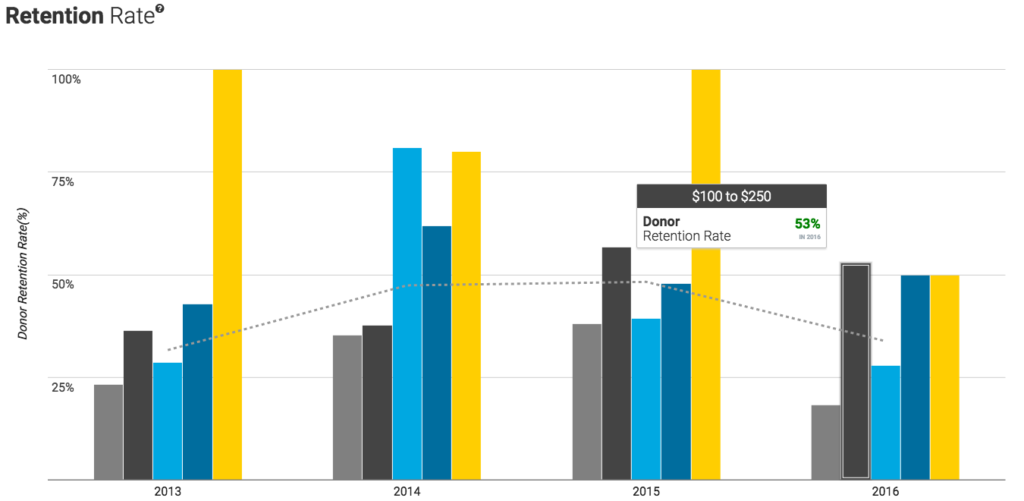You’re busy right now. Trust me, I get it. It’s early December, and in our industry, that can only mean one thing – year end fundraising.
Appeals have been sent (or are in the hands of a trusted Postal Service worker), emails have been delivered and scheduled, and #GivingTuesday has passed. There is a lot of activity going on and a lot of expected donations to come in over the next few days and weeks.
This is a fun, stressful and inspiring time to be a nonprofit professional.
With that in mind, I recently received an email from a new Fundraising Report Card® user that put a smile on my face:
This Development Director had spent hours calculating her organization’s donor retention rate by hand.
That is inspiring, encouraging and admirable! This nonprofit pro get’s it – measuring fundraising metrics like donor retention is crucial to future success. And, doing it at during year end fundraising is imperative to get off to the right start in the coming new year.
In my experience, from talking with hundreds of organizations, there are really two “must calculate” year-end metrics that can help inform strategy in the coming year. You may have a few more metrics on your list, but these two can help inform strategy, set realistic goals, and ultimately help you optimize your fundraising.
Let’s dive in.
Year End Fundraising Metrics to Inform 2017 Strategy
You may have been able to guess them, but donor retention rate, and donor lifetime value are your must calculate metrics. Why? Because between the two you can determine how much you should be willing to spend to acquire new donors and you can set a realistic goal for the coming years donor retention. Both go hand in hand from a strategy standpoint. And, both are critical metrics to know going into a new year.
Donor retention rate
AFP FEP definition
The number of donors last year who gave again this year, divided by total number of donors last year (AFP FEP).

Why measure donor retention rate
When it comes to “buzz” words in our industry, none may be “buzzier” than donor retention rate. But, this is with good reason. It is widely known and accepted that it is cheaper to retain existing donors than it is to acquire new ones. Plus, retained donors tend to be better planned giving and major giving prospects than their “one-off” counterparts.
Retention rates are easy to understand. They represent the percentage of our donors that are renewing their contributions year-over-year. Comparing historical performance can help identify efforts that are increasing or decreasing your donor retention. And, breaking down retention rates by giving level (under $100 donors vs. over $5,000 donors for example) can provide insights into the behavior of your constituents.
Measuring donor retention rate for this year, last year, and the year prior will give you perspective for what your 2017 goal you should be. It’s one thing to aspire for 75% retention, but if your data says you’ve had 20% retention for the past 3 years, it may be more appropriate to set a goal of 25%. No one likes unrealistic benchmarks.
How to calculate donor retention rate
To calculate donor retention rate, you’ll take all retained donors in a year and divide that by all donors from the previous year.
This can become more complicated when calculating donor retention for a specific giving segment. Here is our method at the Fundraising Report Card® for calculating giving segment donor retention:
Take all retained donors from a specific segment and determine which segment they currently belong in. Keep in mind that upgraded and downgraded donor behavior can influence segmented retention rates. For example, a donor could be counted in the $1,000 – $5,000 segment in 2015 and then counted in the retained $5,000+ segment in 2016. This donor would be part of the calculation for 2016, $5,000+ retention rate because they are now a $5,000+ donor.
At it’s core, the retention calculation looks like this:
Donor Retention Rate = Retained Donors (this year) ÷ All Donors (last year)
How to use donor retention rate

After calculating your donor retention rate, you should graph it. Computers are great at reading lines of data in a spreadsheet, but for most of us humans, visual representations are much easier to interpret.
You’ll want an easy to understand visualization of your retention rate so that you can more accurately set a goal for 2017 retention. Because you have calculated retention rate across different giving segments you can even set goals on a per segment basis. Even if you’re a small shop, this is worthwhile. Setting an overall goal of 5% increase in retention is great, but what if that comes at the expense of a 5% decrease in $5,000 donor retention. That wouldn’t be as awesome as it seemed.
You can’t improve what you don’t measure, and heading into 2017, it is more important than ever that you know your key metrics – donor retention rate included.
Donor lifetime value
AFP FEP definition
The AFP FEP has 4 different lifetime value calculations… Here is the one we most closely align with: the financial value ascribed to a donor file in terms of anticipated average giving and expected average years of actual giving.

Why measure donor lifetime value
Donor lifetime value (LTV) is one of those metrics that sounds complicated but is actually quite simple. LTV is hugely important and has roots in the for-profit sector. Knowing your donor lifetime value amounts can directly impact how much money you should be willing to spend to acquire a new donor.
Just like retention rates, it is best practice to break down lifetime value by giving segment. If you were to measure the donor lifetime value without segmentation you would get deceiving results. Donors in your highest dollar segments ($5,000 and up for example) will have lifetime values that skew the results of your entire database.
LTV can be paired with donor acquisition cost (DAC) to figure out exactly how much money you should budget to acquire new donors at each particular segment of your constituency (more on that here). For example, you might find your under $100 donors have a lifetime value of $70. This means you can expect to receive $70 from every new under $100 you acquire this year over the lifetime of their giving. With this in mind, it wouldn’t make sense to spend more than $70 to acquire that new donor.
How to calculate donor lifetime value

Although the concept of lifetime value is relatively simple, actually calculating the metric is more complex. The inputs in our LTV equation are not groundbreaking, they are donor lifespan, average donation amount, and frequency of donation (the number of gifts a donor leaves in one year). But, calculating those inputs can be challenging. Ultimately, the equation for donor lifetime value looks something like this:
LTV = [(Lifespan × Average donation amount) × (Total # of donations ÷ Total # of donors)]
Calculating LTV by giving level is considerably more difficult, but you simply take the inputs from above and find their values across each specific segment you want to analyze.
I highly recommend using the Fundraising Report Card® to calculate your LTV for you. Or, if you really are an Excel wizard, give it a shot.
How to use donor lifetime value
Once you have donor lifetime value metrics you can make really well informed budgeting decisions. As we just discovered, calculating LTV by hand can be incredibly difficult (again that is why I recommend trying the free Fundraising Report Card® to let it do it for you) but once you have those segmented amounts at your disposal you are ready to make really well informed strategic decisions.
Nonprofit leadership today relies more heavily than ever on data-driven decision support, and LTV should be one of the tools you have in your toolbox. Donor LTV should be used to budget donor acquisition expenses and ultimately return on investment.
If you know that the lifetime value of a $1,000 – $2,500 donor is $5,000 then you know exactly how much you should be willing to spend in 2017 to acquire that new donor.
If an under $100 donor has a LTV of $50 you know what your breakeven point is there as well ($50). When thinking strategically about campaigns, events and activities in 2017 keep your donor LTV values in mind as well.
Applying it to your shop
I started this post with the words, “you’re busy.” So you may be saying to yourself, “Zach all this data and metric stuff is great, but I simply don’t have the time to spend hours or days calculating all of it!”
To that I say, do what the user in the email at the beginning of this post did – create a Fundraising Report Card® account and let our software do the heavy lifting for you! These metrics are too important not to calculate, and, thanks to advances in technology, the “I don’t have enough time” excuse is finally starting to become obsolete.
Year end fundraising is a great time to think strategically about improving performance in the coming year. Calculating and monitoring donor retention rates and lifetime values are a great place to start. Happy analyzing!





I’ve mostly “played around” with the Fundraising Report Card in order to get familiar with it. This is our first year for taking a hard look at donor retention. I look forward to using your tool to get the information we need.
Thanks for sharing, Linda! We look forward to helping you get more “data-driven”. Hopefully the Fundraising Report Card will help save you time while uncovering some key insights for the new year.